Input interpretation

H_2O (water) + F_2 (fluorine) ⟶ O_2 (oxygen) + HF (hydrogen fluoride)
Balanced equation
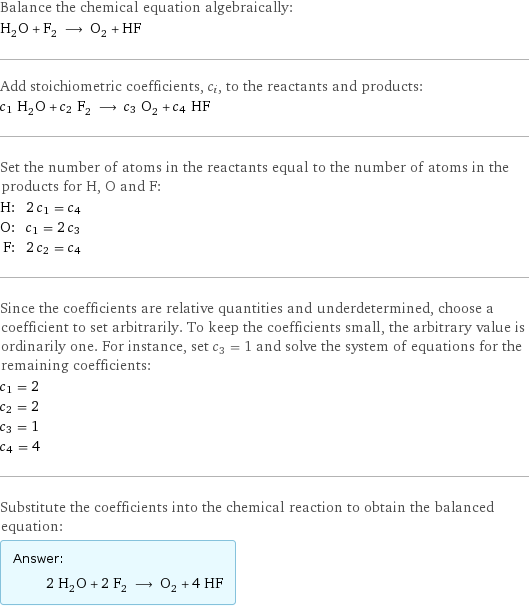
Balance the chemical equation algebraically: H_2O + F_2 ⟶ O_2 + HF Add stoichiometric coefficients, c_i, to the reactants and products: c_1 H_2O + c_2 F_2 ⟶ c_3 O_2 + c_4 HF Set the number of atoms in the reactants equal to the number of atoms in the products for H, O and F: H: | 2 c_1 = c_4 O: | c_1 = 2 c_3 F: | 2 c_2 = c_4 Since the coefficients are relative quantities and underdetermined, choose a coefficient to set arbitrarily. To keep the coefficients small, the arbitrary value is ordinarily one. For instance, set c_3 = 1 and solve the system of equations for the remaining coefficients: c_1 = 2 c_2 = 2 c_3 = 1 c_4 = 4 Substitute the coefficients into the chemical reaction to obtain the balanced equation: Answer: | | 2 H_2O + 2 F_2 ⟶ O_2 + 4 HF
Structures

+ ⟶ +
Names

water + fluorine ⟶ oxygen + hydrogen fluoride
Reaction thermodynamics
Enthalpy
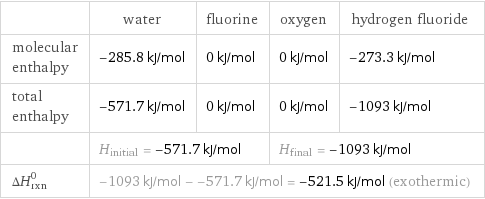
| water | fluorine | oxygen | hydrogen fluoride molecular enthalpy | -285.8 kJ/mol | 0 kJ/mol | 0 kJ/mol | -273.3 kJ/mol total enthalpy | -571.7 kJ/mol | 0 kJ/mol | 0 kJ/mol | -1093 kJ/mol | H_initial = -571.7 kJ/mol | | H_final = -1093 kJ/mol | ΔH_rxn^0 | -1093 kJ/mol - -571.7 kJ/mol = -521.5 kJ/mol (exothermic) | | |
Gibbs free energy
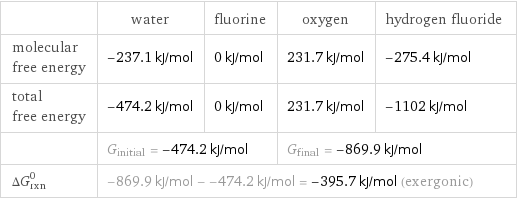
| water | fluorine | oxygen | hydrogen fluoride molecular free energy | -237.1 kJ/mol | 0 kJ/mol | 231.7 kJ/mol | -275.4 kJ/mol total free energy | -474.2 kJ/mol | 0 kJ/mol | 231.7 kJ/mol | -1102 kJ/mol | G_initial = -474.2 kJ/mol | | G_final = -869.9 kJ/mol | ΔG_rxn^0 | -869.9 kJ/mol - -474.2 kJ/mol = -395.7 kJ/mol (exergonic) | | |
Entropy
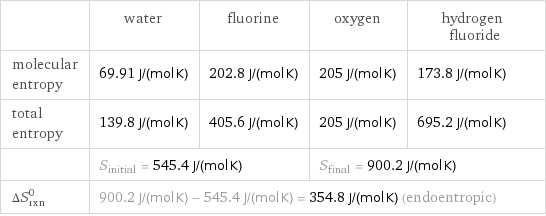
| water | fluorine | oxygen | hydrogen fluoride molecular entropy | 69.91 J/(mol K) | 202.8 J/(mol K) | 205 J/(mol K) | 173.8 J/(mol K) total entropy | 139.8 J/(mol K) | 405.6 J/(mol K) | 205 J/(mol K) | 695.2 J/(mol K) | S_initial = 545.4 J/(mol K) | | S_final = 900.2 J/(mol K) | ΔS_rxn^0 | 900.2 J/(mol K) - 545.4 J/(mol K) = 354.8 J/(mol K) (endoentropic) | | |
Equilibrium constant
![Construct the equilibrium constant, K, expression for: H_2O + F_2 ⟶ O_2 + HF Plan: • Balance the chemical equation. • Determine the stoichiometric numbers. • Assemble the activity expression for each chemical species. • Use the activity expressions to build the equilibrium constant expression. Write the balanced chemical equation: 2 H_2O + 2 F_2 ⟶ O_2 + 4 HF Assign stoichiometric numbers, ν_i, using the stoichiometric coefficients, c_i, from the balanced chemical equation in the following manner: ν_i = -c_i for reactants and ν_i = c_i for products: chemical species | c_i | ν_i H_2O | 2 | -2 F_2 | 2 | -2 O_2 | 1 | 1 HF | 4 | 4 Assemble the activity expressions accounting for the state of matter and ν_i: chemical species | c_i | ν_i | activity expression H_2O | 2 | -2 | ([H2O])^(-2) F_2 | 2 | -2 | ([F2])^(-2) O_2 | 1 | 1 | [O2] HF | 4 | 4 | ([HF])^4 The equilibrium constant symbol in the concentration basis is: K_c Mulitply the activity expressions to arrive at the K_c expression: Answer: | | K_c = ([H2O])^(-2) ([F2])^(-2) [O2] ([HF])^4 = ([O2] ([HF])^4)/(([H2O])^2 ([F2])^2)](../image_source/c9b777000355adf0ea6b00aaf2494434.png)
Construct the equilibrium constant, K, expression for: H_2O + F_2 ⟶ O_2 + HF Plan: • Balance the chemical equation. • Determine the stoichiometric numbers. • Assemble the activity expression for each chemical species. • Use the activity expressions to build the equilibrium constant expression. Write the balanced chemical equation: 2 H_2O + 2 F_2 ⟶ O_2 + 4 HF Assign stoichiometric numbers, ν_i, using the stoichiometric coefficients, c_i, from the balanced chemical equation in the following manner: ν_i = -c_i for reactants and ν_i = c_i for products: chemical species | c_i | ν_i H_2O | 2 | -2 F_2 | 2 | -2 O_2 | 1 | 1 HF | 4 | 4 Assemble the activity expressions accounting for the state of matter and ν_i: chemical species | c_i | ν_i | activity expression H_2O | 2 | -2 | ([H2O])^(-2) F_2 | 2 | -2 | ([F2])^(-2) O_2 | 1 | 1 | [O2] HF | 4 | 4 | ([HF])^4 The equilibrium constant symbol in the concentration basis is: K_c Mulitply the activity expressions to arrive at the K_c expression: Answer: | | K_c = ([H2O])^(-2) ([F2])^(-2) [O2] ([HF])^4 = ([O2] ([HF])^4)/(([H2O])^2 ([F2])^2)
Rate of reaction
![Construct the rate of reaction expression for: H_2O + F_2 ⟶ O_2 + HF Plan: • Balance the chemical equation. • Determine the stoichiometric numbers. • Assemble the rate term for each chemical species. • Write the rate of reaction expression. Write the balanced chemical equation: 2 H_2O + 2 F_2 ⟶ O_2 + 4 HF Assign stoichiometric numbers, ν_i, using the stoichiometric coefficients, c_i, from the balanced chemical equation in the following manner: ν_i = -c_i for reactants and ν_i = c_i for products: chemical species | c_i | ν_i H_2O | 2 | -2 F_2 | 2 | -2 O_2 | 1 | 1 HF | 4 | 4 The rate term for each chemical species, B_i, is 1/ν_i(Δ[B_i])/(Δt) where [B_i] is the amount concentration and t is time: chemical species | c_i | ν_i | rate term H_2O | 2 | -2 | -1/2 (Δ[H2O])/(Δt) F_2 | 2 | -2 | -1/2 (Δ[F2])/(Δt) O_2 | 1 | 1 | (Δ[O2])/(Δt) HF | 4 | 4 | 1/4 (Δ[HF])/(Δt) (for infinitesimal rate of change, replace Δ with d) Set the rate terms equal to each other to arrive at the rate expression: Answer: | | rate = -1/2 (Δ[H2O])/(Δt) = -1/2 (Δ[F2])/(Δt) = (Δ[O2])/(Δt) = 1/4 (Δ[HF])/(Δt) (assuming constant volume and no accumulation of intermediates or side products)](../image_source/0e196e44fc816895f0b1e44ffe4c23ce.png)
Construct the rate of reaction expression for: H_2O + F_2 ⟶ O_2 + HF Plan: • Balance the chemical equation. • Determine the stoichiometric numbers. • Assemble the rate term for each chemical species. • Write the rate of reaction expression. Write the balanced chemical equation: 2 H_2O + 2 F_2 ⟶ O_2 + 4 HF Assign stoichiometric numbers, ν_i, using the stoichiometric coefficients, c_i, from the balanced chemical equation in the following manner: ν_i = -c_i for reactants and ν_i = c_i for products: chemical species | c_i | ν_i H_2O | 2 | -2 F_2 | 2 | -2 O_2 | 1 | 1 HF | 4 | 4 The rate term for each chemical species, B_i, is 1/ν_i(Δ[B_i])/(Δt) where [B_i] is the amount concentration and t is time: chemical species | c_i | ν_i | rate term H_2O | 2 | -2 | -1/2 (Δ[H2O])/(Δt) F_2 | 2 | -2 | -1/2 (Δ[F2])/(Δt) O_2 | 1 | 1 | (Δ[O2])/(Δt) HF | 4 | 4 | 1/4 (Δ[HF])/(Δt) (for infinitesimal rate of change, replace Δ with d) Set the rate terms equal to each other to arrive at the rate expression: Answer: | | rate = -1/2 (Δ[H2O])/(Δt) = -1/2 (Δ[F2])/(Δt) = (Δ[O2])/(Δt) = 1/4 (Δ[HF])/(Δt) (assuming constant volume and no accumulation of intermediates or side products)
Chemical names and formulas
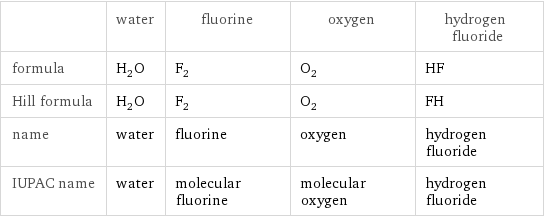
| water | fluorine | oxygen | hydrogen fluoride formula | H_2O | F_2 | O_2 | HF Hill formula | H_2O | F_2 | O_2 | FH name | water | fluorine | oxygen | hydrogen fluoride IUPAC name | water | molecular fluorine | molecular oxygen | hydrogen fluoride